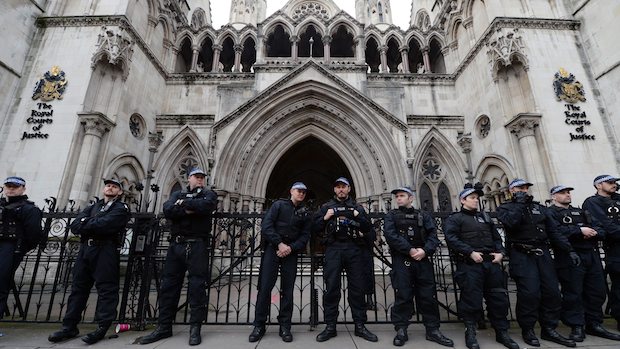
File photo of the Royal Courts of Justice in London, England, taken in January 2014. (EPA/ANDY RAIN)
Late last month, Libya’s sovereign wealth fund sued the global investment bank Goldman Sachs at London’s High Court. It is alleged that the fund lost in excess of 1 billion US dollars in 2008 through poor investments advised by Goldman, which denies the allegations.
Prior to the 2011 uprisings, the Libyan Investment Authority (LIA) was often portrayed by the international media as one of the few instances of true modernization occasioned by Gaddafi’s détente with the West. It had offices in London and its chairman, Mohamed Layas, was about as seasoned a technocrat as the Libyans had to offer. The country’s longstanding dictator, Colonel Muammar Gaddafi, created the LIA in 2006 as part of the Monitor Group-inspired New Economic Strategy. It was a vehicle to invest the proceeds of the country’s oil wealth, but it was also part of the Libyan glasnost orchestrated between the colonel and Western powers to reintegrate Libya into the international community, swapping business opportunities in Libya in exchange for regional security.
During the rush after Gaddafi’s détente with the US in 2003, the LIA was courted by successive Western companies and invested in assets as diverse as the Dutch–Belgian bank Fortis and the Italian football club Juventus. Previous reports and court documents paint a picture of an inexperienced management team at the LIA wowed by sophisticated Western financiers. This, however, is a vast oversimplification.
The LIA was a vehicle for a different kind of corruption: the corruption of the so-called free market reformer, as practiced by Saif Al-Islam Gaddafi and his allies, Shukri Ghanem and Mustafa Zarti. The traditional corruption of the hardline faction within Libya—including figures such as Mutassim Gaddafi and Baghdadi Mahmudi—was predicated on tightly regulating Libya’s access to outside expertise. The reformists’ corruption was about selling preferential access to Libya’s institutions to various foreign entities and, frequently, squandering the Libyan people’s money on deals that involved kickbacks for Zarti and his buddies. In addition to sophistication in carrying out corrupt schemes, the LIA turned out to lack basic knowhow in investing and due diligence.
The LIA’s investment strategy included bets on the international capital markets. According to LIA documents, Goldman arranged for the investment of a total of 1.2 billion US dollars in complex derivative trades, effectively placing bets on a basket of currencies and a rise in the share price of six companies: Citigroup, EDF, Santander, Allianz, Eni and UniCredit. This left the LIA heavily exposed to financial shocks, which meant the fund lost virtually all of its initial investment during the aftermath of the 2008 financial crisis. According to the Wall Street Journal, the LIA’s deputy chairman, Mustafa Zarti, summoned Goldman’s director in North Africa, Youssef Kabbaj, and berated him “like a raging bull,” apparently swearing at and threatening Goldman employees.
The LIA now claims the deal was clouded by opaque structures and misleading advice. This, however, seems unlikely to be the full explanation despite how convenient it would be for the post-Gaddafi Libyan authorities. Given Zarti’s endorsment of other bad trades for the LIA on which he stood to gain personally, it is far more likely that Zarti and those around him were involved in various side actions with Goldman surrounding the losses. However, Zarti and Goldman would have been very careful to avoid leaving any sort of paper trail.
For Libyan politicians, the pending case represents an opportunity for the country’s new leaders to claw back losses incurred during Gaddafi’s reign, as well as to expose the corruption of the former regime and its nefarious and unscrupulous dealings with the Libyan people’s money.
Beyond the Goldman case, the murky dealings between the LIA and Western funds remain to be uncovered. There is much anecdotal information from Libyans in the banking sector suggesting that the LIA may have just as easily taken advantage of Western firms as the reverse. It was recently reported that the US Department of Justice has now joined the Securities and Exchanges Commission in investigating allegations that Libyan banks and other financial institutions may have violated anti-bribery laws prior to the 2011 revolution. The saga of the rebels and the bankers looks set to run on and on. The popular press is quick to blame predatory Western companies for defrauding the Libyan people. Although this may describe part of the reality, it is certainly not the whole truth. Given the patterns of the Gaddafi regime and some information uncovered by Margaret Coker of the Wall Street Journal in 2011, it is not impossible that the LIA, Goldman, and the political echelon in Gaddafi’s Libya were all in on it.
This article was originally published in The Majalla.
All views expressed in this blog post are those of the author and do not necessarily represent the views of, and should not be attributed to, The Majalla magazine or Asharq Al-Awsat newspaper.
